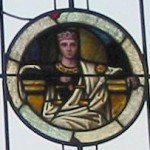 In the previous post, I detailed how the figure to the left of Moses must be Sir William Blackstone. I had thought that the figure to the right of Moses was King Solomon. The iconography of the throne, crown, royal purple, and scales all point to Solomon. However, this figure is beardless, and artists have traditionally depicted Solomon as a bearded, often old, king (see, e.g., a ninth-century German illuminated Bible, and Renaissance depictions such as the panel of Solomon meeting the Queen of Sheba panel from Ghiberti’s famed “Golden Doors” of the Florentine Baptistry, and also the fresco by Piero della Fransceca in Arezzo). On the other hand, artists from later centuries did portray the famous ruler as clean-shaven (see, e.g., this 18th-century Russian icon, and an engraving by the 19th-century master Gustav Doré).
In the previous post, I detailed how the figure to the left of Moses must be Sir William Blackstone. I had thought that the figure to the right of Moses was King Solomon. The iconography of the throne, crown, royal purple, and scales all point to Solomon. However, this figure is beardless, and artists have traditionally depicted Solomon as a bearded, often old, king (see, e.g., a ninth-century German illuminated Bible, and Renaissance depictions such as the panel of Solomon meeting the Queen of Sheba panel from Ghiberti’s famed “Golden Doors” of the Florentine Baptistry, and also the fresco by Piero della Fransceca in Arezzo). On the other hand, artists from later centuries did portray the famous ruler as clean-shaven (see, e.g., this 18th-century Russian icon, and an engraving by the 19th-century master Gustav Doré).
However, noticeably absent from the stained glass was any iconography of a sword (cf. ‘splitting the baby’ from 1 Kings 3:16-28). A fellow law student held that the figure was really King David.
One authority, though, holds that the figure is neither David nor Solomon. During his spring 2008 visit to the law school, Judge Pryor of the US Court of Appeals for the Eleventh Circuit, who had identified Blackstone, offered Lady Justice as the likely candidate. This would account for the beardlessness, and the classic imagery of the scales is present. However, absent are the iconic sword and blindfold, and Lady Justice usually is not crowned. It’s a tough call. I welcome feedback to solve this art history mystery….

As long as you are looking into Law School art mysteries, perhaps someone can find out why the owl and bat figures are carved into the front of the arch over the Wisconsin Avenue entrance to Sensenbrenner Hall. I am assuming the “wise owl” and perhaps a “blind bat” because justice is blind, but we have not been able to figure out why those images are with us.
Anyone interested in art history mysteries should check out The Jewel Trilogy: (The Napoleon Connection, Carlota’s Legacy and The Brotherhood Wars) three mysteries loaded with art history and intrigue. Popular with young readers, art history enthusiasts and alternative-sexual buffs. Available on Lulu.com (for anyone with a personal computer) or on Amazon.com (for anyone with a Kindle reader).
Just a guess but how about Emperor Justinian I of what we would now call the Byzantine Empire (though he and his successors no-doubt saw themselves as Roman Emperors along the lines of Augustus and Trajan.)
The beardlessness, the regal purple and also white garb and even the style of crown all seem evocative of the Eastern Roman Empire. Also, as the driving force behind the Code of Roman Law, Emperor Justinian would no doubt be worthy company for Moses and Blackstone.
Compre this picture to image in window.
http://historyofscience.com/G2I/timeline/images/justinian.jpg
Dan,
Emperor Justinian is a novel and intriguing choice: you have my vote. The brooch clinches it for me. Viva Corpus Iuris Civilis! Note, too, that the Code of Justinian undergirds Canon Law, apt for a Catholic Jesuit law school.